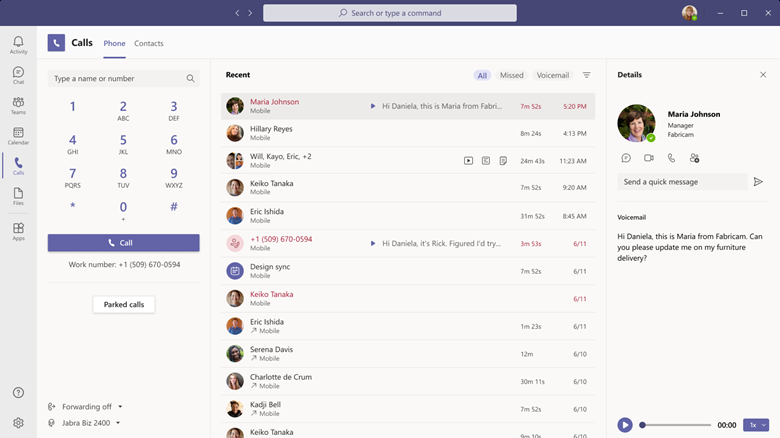The advent of virtual meetings has revolutionised collaborative workspaces, making video-based collaboration an integral part of modern business practices. As we transition into a hybrid work environment, the transformation of phone calls is now on the horizon. Microsoft Teams Phone, with nearly 80 million users spanning over 180 countries, is at the forefront of this evolution.
Technological Foundations: PSTN and VoIP
At the heart of Teams Phone lies two pivotal technologies: the Public Switched Telephone Network (PSTN), which has been facilitating voice calls since the late 1800s, and Voice over Internet Protocol (VoIP), which routes calls over the Internet, enabling enriched experiences like video and screen sharing. While PSTN usage remains prevalent, the adoption of VoIP is surging. In a bold move, UK-based operator BT announced plans to retire the PSTN network by 2025, opting to route all calls over IP.
Navigating the Path Ahead
In the face of this transition, calling solution providers face a crucial decision. Should they invest in coding numerous telephony features, or prioritize the most critical PSTN needs while fostering modern calling experiences? Teams Phone has opted for the latter, guided by key trends that shape their innovation agenda:
1. Collaboration experiences set the standard:
Users now expect seamless integration of calls into their existing collaboration tools. This shift is evident in the 50 percent increase in Teams Phone calls originating from chats compared to the previous year.
2. Rise of VoIP in inter-organizational calls
Teams Phone paves the way for secure VoIP-based voice or video calling, screen sharing, and chat between organizations, facilitating seamless cross-company communication.
3. Empowering a mobile workforce:
Hybrid workers require flexible, reliable mobile calling solutions. Teams Phone accommodates this need, ensuring productivity across various devices, including PCs and mobile phones.

The advent of virtual meetings has revolutionised collaborative workspaces, making video-based collaboration an integral part of modern business practices. As we transition into a hybrid work environment, the transformation of phone calls is now on the horizon. Microsoft Teams Phone, with nearly 80 million users spanning over 180 countries, is at the forefront of this evolution.
Technological Foundations: PSTN and VoIP
At the heart of Teams Phone lies two pivotal technologies: the Public Switched Telephone Network (PSTN), which has been facilitating voice calls since the late 1800s, and Voice over Internet Protocol (VoIP), which routes calls over the Internet, enabling enriched experiences like video and screen sharing. While PSTN usage remains prevalent, the adoption of VoIP is surging. In a bold move, UK-based operator BT announced plans to retire the PSTN network by 2025, opting to route all calls over IP.
Navigating the Path Ahead
In the face of this transition, calling solution providers face a crucial decision. Should they invest in coding numerous telephony features, or prioritize the most critical PSTN needs while fostering modern calling experiences? Teams Phone has opted for the latter, guided by key trends that shape their innovation agenda:
1. Collaboration experiences set the standard:
Users now expect seamless integration of calls into their existing collaboration tools. This shift is evident in the 50 percent increase in Teams Phone calls originating from chats compared to the previous year.
2. Rise of VoIP in inter-organizational calls
Teams Phone paves the way for secure VoIP-based voice or video calling, screen sharing, and chat between organizations, facilitating seamless cross-company communication.
3. Empowering a mobile workforce:
Hybrid workers require flexible, reliable mobile calling solutions. Teams Phone accommodates this need, ensuring productivity across various devices, including PCs and mobile phones.

In pursuit of a future where calling seamlessly integrates into workflow, Teams Phone is introducing several features:
1. Seamless device transfers:
Move calls effortlessly between devices without disrupting the conversation, enhancing mobility and convenience for users.
2. Combatting spam calls:
Advanced techniques identify likely spam calls, preserving productivity by allowing users to filter unwanted interruptions.
3. Apple CarPlay support:
Aligning with the return of commuting, Teams now supports Apple CarPlay, enabling hands-free participation in calls and meetings.
4. One-to-one call transcription and recording:
Users will soon have the option to record and transcribe one-to-one calls, streamlining information retention and accessibility.
Bridging the Gap: Existing Telephony and Teams
While VoIP heralds the future of calling, PSTN calls remain pivotal for many organizations. Teams Phone bridges this gap with new capabilities:
1. Operator Connect:
This feature allows customers to seamlessly integrate their operator-based PSTN service into Microsoft Teams, streamlining infrastructure management and providing shared technical support.
2. Microsoft Teams Calling Plans expansion:
This simplified deployment option is expanding into five new markets, extending the total coverage to 33 markets.
3. Bring your own contact centre :
Teams Phone now integrates with existing contact center solutions, streamlining deployment and ensuring seamless integration.
Pioneering Purpose-Built Devices
Teams Phone is revolutionising device functionality, enhancing user experiences:
1. “Better together” experience:
Devices now complement each other, offering a unified experience, allowing users to seamlessly manage calls.
2. Walkie-talkie for desk phones:
A new walkie-talkie feature enhances quick communication, optimising efficiency in the workspace.
Looking Forward
These advancements are a testament to Teams Phone’s commitment to fostering spontaneous collaboration and preparing organisations for the future of calling. Recognized as a Leader in the 2020 Gartner Magic Quadrant for Unified Communications as a Service, Teams Phone is the linchpin for modernising communication strategies.
Embracing the Future of Calling
Leading organisations like LVMH are embracing Teams Phone as a vital component of their modernisation journey. By integrating calling, chat, and collaboration, Teams Phone ensures that everyone stays in the flow of their work, setting a new standard for the future of communication.
“Teams’ numerous features bring together what we see as the essential linchpins of communication…”– Frank Le Moal, Chief Information Officer, LVMH.


